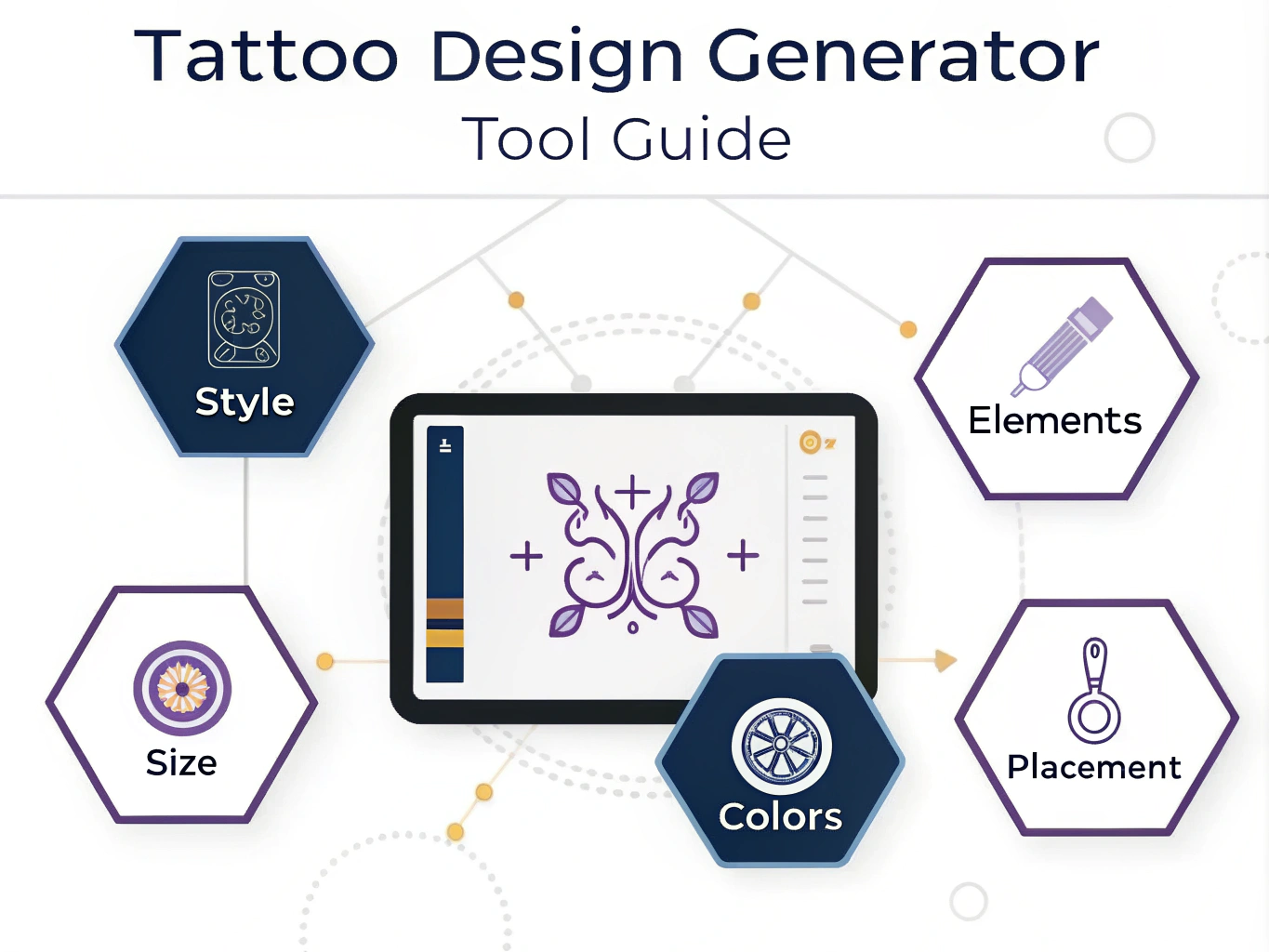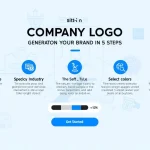Tattoo Design Generator
Is this tool helpful?
How to Use the Tattoo Design Generator Tool Effectively
This Tattoo Design Generator Tool helps you create a unique tattoo concept based on your personal style and preferences. Follow these steps to get the most out of the tool:
- Style or theme of the tattoo: Describe the overall look or vibe you want, such as “Art Deco geometric patterns” or “Surrealism-inspired abstract shapes.”
- Main elements or symbols to include: List specific motifs or figures you want featured, for example, “Wolf howling at moon” or “Cherry blossom branch with birds.”
- Preferred colors (Optional): Share your color choices like “Earth tones with muted greens and browns” or “Bold black and deep red contrast.”
- Approximate size (Optional): Specify the general size of the tattoo, such as “Quarter sleeve” or “Small, about 2 inches.”
- Intended placement area (Optional): Indicate where you want the tattoo on your body, for instance, “Calf muscle” or “Upper chest close to collarbone.”
- Click the Generate Tattoo Design button to receive a detailed design concept tailored to your input.
After generating your tattoo concept, review the description carefully. You can copy the text to use as inspiration during consultations with your tattoo artist or as a foundation to develop your design further.
What Is the Tattoo Design Generator Tool? Purpose and Benefits
The Tattoo Design Generator Tool is an interactive online resource that translates your tattoo ideas into clear, creative design concepts. It combines your style preferences, symbols, and colors to craft detailed tattoo descriptions that help you visualize your ideal ink.
Core Benefits of Using This Tool
- Jump-starts creativity: The tool suggests fresh design ideas based on your input, breaking through creative blocks.
- Saves time and effort: Instead of multiple sketches or consultations, explore varied concepts quickly and easily.
- Reduces risk: Visualizing your tattoo beforehand lets you refine your ideas and avoid future regret.
- Improves communication: Use generated concepts to clearly explain your vision to a tattoo artist.
- Explores styles: Try different tattoo styles and themes to find what fits your aesthetic.
- Customizes meanings: Incorporate symbols or elements that carry personal significance for a meaningful tattoo design.
Practical Uses of the Tattoo Design Generator Tool
This tool shines in various tattoo planning scenarios:
1. Planning Your First Tattoo
If you’re new to tattoos, this generator helps you explore different design possibilities without pressure. Try styles or symbols that interest you and get clear design concepts to build confidence before committing.
Example:
Emma wants something meaningful and clean. She inputs “Japanese minimalism” as her style, “Koi fish and lotus flower” for symbols, and “forearm” for placement. The tool offers a refined concept that highlights flowing lines and subtle water elements, helping Emma picture her first tattoo clearly.
2. Cover-Up Tattoo Ideas
For those wanting to cover or revise an existing tattoo, use the tool to generate design concepts that incorporate your current ink or mask it creatively.
Example:
John wants to cover an old anchor tattoo on his bicep. He inputs “blackwork” style with “thorny vines and skulls” as elements, specifying a “large” size and “upper arm” placement. The tool creates a concept that integrates bold black lines and details that cleverly camouflage the original anchor.
3. Refining Tattoo Ideas for Experienced Enthusiasts
You can use the tool to experiment with new styles or elements before your next session. This helps you visualize how different motifs or placements might look together, reducing guesswork in your ongoing tattoo journey.
Understanding the Digital Design Process Behind the Tool
While the Tattoo Design Generator focuses on concept creation rather than actual artwork, it applies a blend of art and digital science to offer detailed, coherent descriptions grounded in your input.
How Style, Symbols, Colors, Size, and Placement Shape Your Design
- Style analysis: Recognizes tattoo genres like realism, neo-traditional, or blackwork to guide the concept’s tone and motifs.
- Symbol meaning: Interprets your listed elements to ensure they fit culturally and thematically within the design.
- Color theory: Applies harmonious color schemes based on your preferred palette.
- Design scale: Adjusts suggested motifs for your described tattoo size.
- Placement fit: Creates ideas that suit your chosen body area’s shape and contour.
Mathematical Concepts Behind Digital Tattoo Design Descriptions
While you won’t see actual images, the tool’s conceptual framework builds on mathematical principles used in digital art:
1. Geometric Transformations
Design elements are imagined through scaling, rotation, and translation, calculated by formulas like:
$$ (x_{new}, y_{new}) = (x_{original} \times s_x, y_{original} \times s_y) $$$$ \begin{pmatrix} x_{new} \\ y_{new} \end{pmatrix} = \begin{pmatrix} \cos\theta & -\sin\theta \\ \sin\theta & \cos\theta \end{pmatrix} \begin{pmatrix} x_{original} \\ y_{original} \end{pmatrix} $$$$ (x_{new}, y_{new}) = (x_{original} + t_x, y_{original} + t_y) $$2. Color Calculations
The tool considers color blending and contrast using the RGB model and blending formulas such as:
$$ C_{result} = \alpha C_1 + (1 – \alpha) C_2 $$Where $alpha$ controls the blend ratio between two colors.
3. Bézier Curves for Smooth Design Lines
Bézier curves help visualize fluid, artistic shapes common in tattoo designs:
$$ B(t) = (1-t)^3 P_0 + 3(1-t)^2 t P_1 + 3(1-t) t^2 P_2 + t^3 P_3 $$$t$ ranges from 0 to 1, guiding the curve from start to end points.
Why Use a Tattoo Design Generator? Key Advantages for You
1. Spark Your Creative Flow
The tool generates custom tattoo ideas based on your unique input. This helps you explore designs you may not have imagined, broadening your creative options.
2. Save Time and Money
Instead of multiple design drafts or meetings, you experiment with ideas instantly online, speeding up your tattoo planning and reducing costs.
3. Minimize Tattoo Regret
Visualizing your tattoo concept before getting inked helps you avoid designs that don’t suit you, leading to greater satisfaction with your tattoo.
4. Collaborate Effectively With Your Tattoo Artist
Use the generated concept as a communication tool. It provides a clear starting point for discussions and adjustments with your artist to get precisely what you want.
5. Discover and Experiment with Different Tattoo Styles
Unsure which style fits you best? Try various styles in the tool to find the aesthetic that matches your personality and taste.
6. Custom Designs With Meaning
By specifying your own symbols and themes, the generated designs are deeply personal, going beyond just visual appeal to hold significant meaning.
Important Disclaimer
The calculations, results, and content provided by our tools are not guaranteed to be accurate, complete, or reliable. Users are responsible for verifying and interpreting the results. Our content and tools may contain errors, biases, or inconsistencies. Do not enter personal data, sensitive information, or personally identifiable information in our web forms or tools. Such data entry violates our terms of service and may result in unauthorized disclosure to third parties. We reserve the right to save inputs and outputs from our tools for the purposes of error debugging, bias identification, and performance improvement. External companies providing AI models used in our tools may also save and process data in accordance with their own policies. By using our tools, you consent to this data collection and processing. We reserve the right to limit the usage of our tools based on current usability factors.







